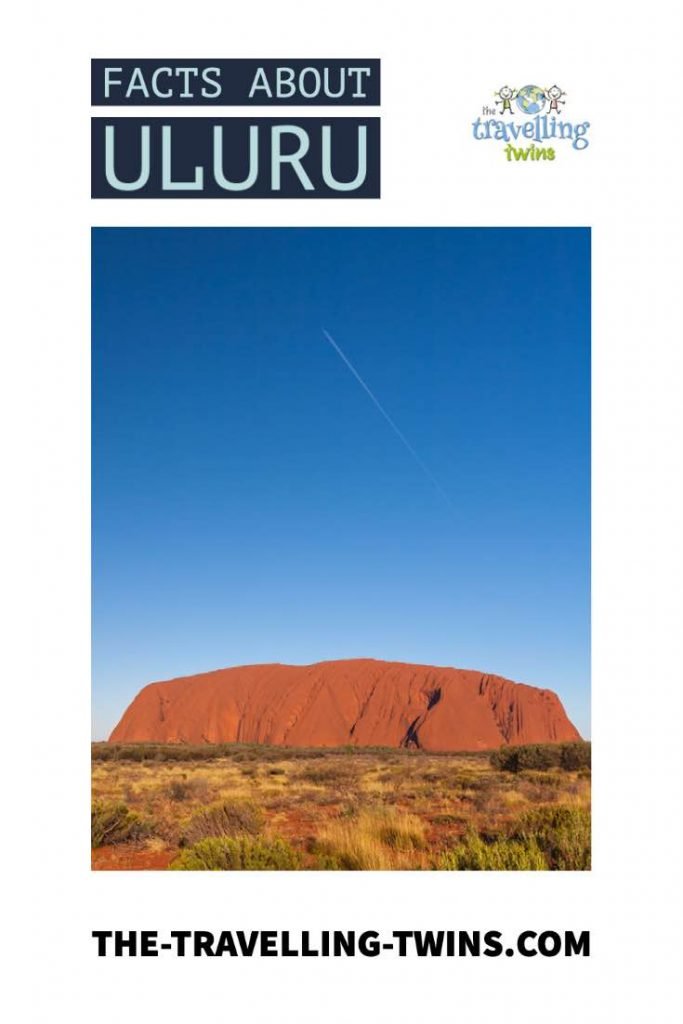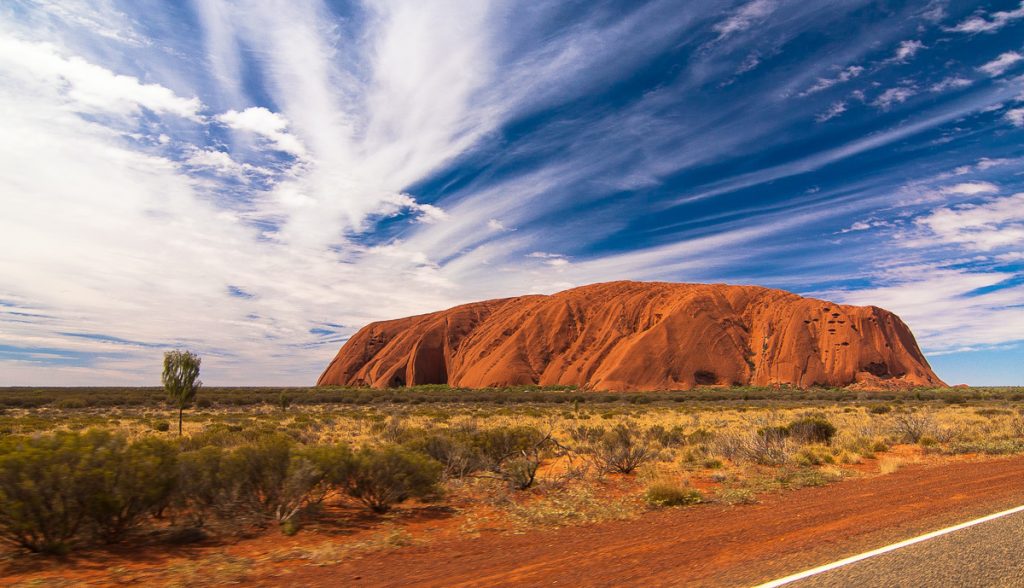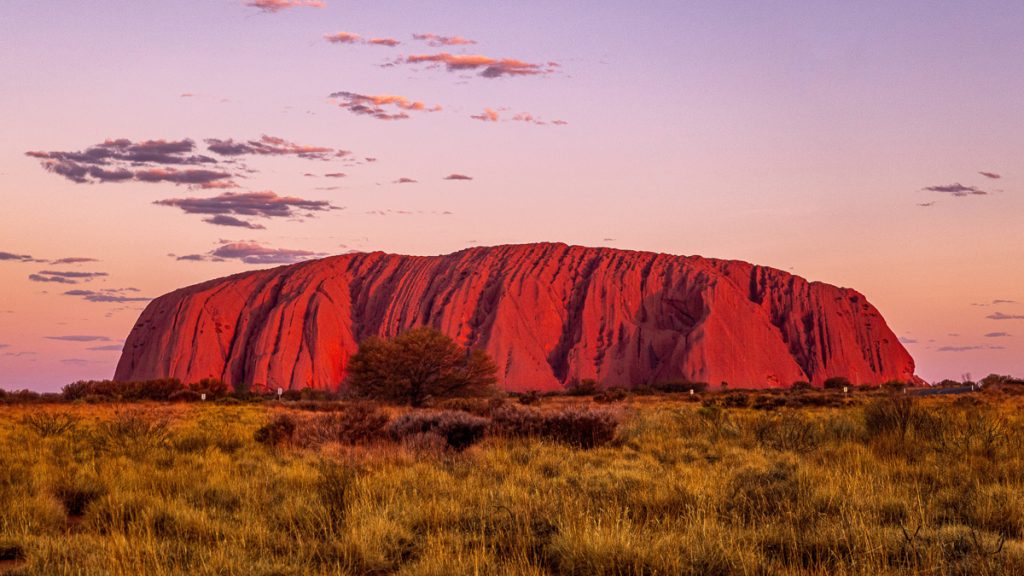Visiting and travelling through Australia, is for some trip of the lifetime. The Downunder country is vast with lots of natural wonders, but one of the famous Landmarks in Australia is Uluru – the sacred place for Aborigines People. Before you will visit you should read interesting facts about Uluru.

Uluru or Ayers Rock is a gigantic sandstone rock formation located in the southern region of the Northern Territory in central Australia around 208 miles southwest of Alice Springs. Despite what people believe Ayers Rock is not the biggest rock in the world, and not even in Australia, as Mount Augustus in western Australia is more then twice the size.
The area surrounding the rock has been inhabited for thousands of years and today, the monolith and the Aboriginal culture that imbues the area are highly entangled in a historical narrative that stretches generations.
The rock is believed to have been formed by ancestral beings actions during the Dreaming. Until today, rituals are held in the sacred caverns surrounding the base of the rock. Dreaming refers to the time when the people and the land were created by the ancestor spirits.
Uluru has formed around 600 million years ago. Rock is a sacred landmark to the Pitjantjatjara, the Anangu people that live around the area. The Anangu are the Aboriginal people that have been living on these lands since the beginning before even the European settlers came in the 1800s. This local tribe dates over 60,000 years and its culture has been an important aspect of Central Australian life.
The Anangu called the landmark Uluru, a local word that has no further specific meaning in the Pitjantjatjara dialect other than its use as a local family name by the senior Traditional Owners of Uluru. The landmark was first found by outside in 1873, a surveyor named William Gosse, who also named it Ayers Rock after the then Chief Secretary of South Australia, Sir Henry Ayers. Today, the rock is called both Ayers Rock and Uluru after a dual naming policy was adopted in 1993 to allow official names to comprise of both the English name and traditional Aboriginal name.
Facts about Ayers Rock – Uluru Rock
Dual World Heritage Site
First, the landmark was UNESCO listed in 1987 in recognition for its unique geology and seven years later, it was listed as a cultural site for its significance to the local Aboriginal people Australians.

Climbing Uluru
- Visitors began climbing the rock in the late 1930s and in 1964, a climbing chain was installed to keep climbers safe. But in the 1990s, a sign was put up at the foot of the rock asking visitors to “Please Don’t Climb” on behalf of the Anangu people.
- In 2019, the rock was closed for climbing.
- Prince Charles and Princess Diana climbed Uluru when they visited the region in 1983.
- One of the reasons the locals wanted people to be banished from climbing the rock was that the path crossed a significant dream time track related to Mala rites. Also, 37 people died climbing the rock in recent decades and the Anangu people felt some sense of responsibility when someone died on Uluru.
The color of Uluru
The Uluru has always been associated with its burnt orange colour; however, the formation is naturally grey. Comprised of arkose sandstone, its widely known red hue is caused by iron oxidation on its surface. The rock also changes its color depending on the time of the day, going from red to modest salmon, rust, and every colour in between.

Taller than the Eiffel Tower
Standing at 348 meters tall, Uluru is not only taller than the Eiffel Tower but also several other famous landmarks around the world, including the Chrysler Building in New York City.
Much of its size is buried underground
Uluru is a gigantic monument, but it is even bigger underground, with its beneath the surface believed to extend more than 2 kilometers.
It takes 3.5 hours to circumnavigate its base
The formation is 3.6 kilometres long and 1.9 kilometres wide with a circumference of 9.4 kilometers. With that in mind, it will take you 3.5 hours to walk around its base, though a huge chunk of that time will be used to get around a variety of landscapes.
Flora and fauna of Uluru
Despite being surrounded by a desert, Uluru is home to diverse plants and animals. It is home to more than 400 species of plants, many of which are used by the Anangu people as food, tools, and medicines. There are also plenty of animals in the area including more than 20 species of mammals like red kangaroos, dingoes, and the spinifex skipping mouse.
Strange facts about Ayers Rock
- The surface of Uluru is littered with numerous rock art sites depicting ancient stories. The paintings, drawings and writings on the rock date back 5,000 years and they include animal tracks and concentric circles.
- If you disobey the wishes of the Aboriginal Culture and climb Uluru, you will die!
- Believe it or not, most of the 37 climbers who died while trying to climb Uluru had disrespected the Aboriginal Culture.
- The locals have never climbed Uluru – The Anangu community has never climbed Uluru because it holds significant spiritual importance to them, thus explaining why they requested visitors to be banned from climbing.
- The rock was once under the seabed – During the Neoproterozoic period, most of Australia was covered by the Centralian Superbasin, which means that Uluru was submerged under the water in an area known as Amadeus Basin. But after millions of years of evolution that changed the surface of the earth, today, the formation sits more than 860 meters above sea level.
- Photographic restrictions – The rock also has photographic restrictions associated with the traditional Tjukurpa beliefs and the Anangu tribe request that tourists refrain from taking photographs of these areas. Commercial photography is highly regulated and one must obtain a permit before embarking on photographing the rock.
- The rock texture Looking from far, it may seem that the surface of Uluru is smooth. However moving closer, you will realize that it is actually rough and rugged with a variety of ridges, slopes, canyons, grooves, and caves. The local community believes that the imperfections of the surface texture symbolize the expeditions of their ancestors.
- Shrimps live in Uluru – When it rains heavily, some small shield shrimps hatch in temporary rock pools and waterholes around the rock. When the water dries up, the shrimp eggs dry up and remain dormant for years until the next heavy rainfall.
Facts about Ayers Rock – Pin it



Privacy Policy Disclaimer
This website uses affiliate links for income and support.
If you like our website please consider using these links. You will be directed to the vendor, and we will get a small commission on your purchase price at no increased cost to you.
We have researched facts stated here as far as practicable but please check anything critical before committing your time and money. We do not claim any special knowledge or expertise.
